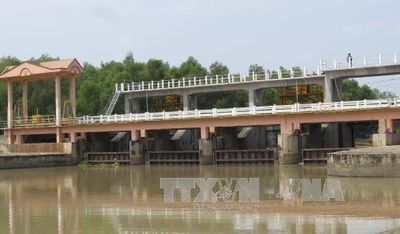 Environment
Environment

Provinces in the Mekong Delta are taking prompt action to help local residents adapt to drought and saltwater intrusion during the dry season.

|
| Xuân Hòa Sluice in Tiền Giang Province’s Chợ Gạo District. — VNA/VNS Photo Hồng Nhung |
HCM CITY — Provinces in the Mekong Delta are taking prompt actions to help local residents adapt to drought and saltwater intrusion during the dry season.
Every year, severe saltwater intrusion occurs in Tiền Giang Province’s Tân Phú Đông District, which is located at the lower section of Tiền River and between the river mouths of Tiểu and Đại, according to Nguyễn Quốc Khánh, chairman of the district People’s Committee.
The province has allocated more than VNĐ26 billion (US$1.1 million) for irrigation systems to protect production and the life of local residents.
The capital is being used to dredge a total of 3,000 metres of eight canals that will be used to store fresh water, and build three new sluices that will prevent saltwater intrusion in Tân Thới and Phú Đông communes.
It is also being used to upgrade three embankments to protect nearly 5,560 hectares of land for production, including 2,950 hectares of coconuts and more than 1,250 hectares of fruit, among others.
District authorities have urged farmers to use methods that adapt to climate change and to expand areas for vegetable cultivation in paddy fields so that water can be saved.
In areas near sea and embankments, farmers have upgraded more than 320 hectares for shrimp breeding.
In Trà Vinh Province, the Centre for Fresh Water and Rural Environmental Hygiene has built works connecting tap water supply systems and has provided devices containing fresh water for residents in areas affected by drought and saltwater intrusion.
Bùi Văn Mừng, the centre’s director, said that more than 4,600 households lacked fresh water, most of them in remote areas in Châu Thành, Cầu Kè, and Càng Long districts.
The areas affected by saline intrusion do not have enough tap water supply stations or systems. Saltwater intrusion has increased since February, while all main sluices in the province have been closed to store fresh water and prevent saline intrusion.
Local resident Thạch Sa Ri of Đa Lộc Commune in Châu Thành District has been using drilled well water, but "the well has gone dry because of the lack of rain".
Mừng said that the province has allocated nearly VNĐ12 billion to expand fresh water supply systems for areas affected by drought and saltwater intrusion.
The system will provide tap water to nearly 4,000 households in the districts of Càng Long and Châu Thành by the second quarter of the year.
For households in areas where the system’s pipeline cannot access, the centre will provide devices to contain water.
Bến Tre Province has 4,962 households that lack devices to store fresh water. Its authorities have suggested that the Việt Nam Fatherland Front Central Committee provide drinking water jugs for the poor.
Vĩnh Long Province has an irrigation system with more than 5,000 canals and others, more than 400 embankments and more than 6,000 sluices to ensure water for agricultural production.
The province needs VNĐ200 billion to dredge the La Ghì-Trà Côn Canal in Trà Ôn District to serve 30,000 hectares and another VNĐ250 billion for the Cái Cá- Mây Tức irrigation system in Vũng Liêm District to serve 45,000 hectares. It has petitioned the Government for the assistance.
According to the Ministry of Agriculture and Rural Development, saltwater intrusion is forecast to increase from March 7 to 15 due to high tides and be at the highest level since the beginning of the dry season. — VNS